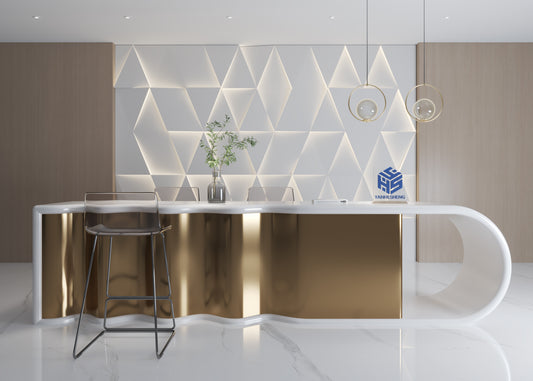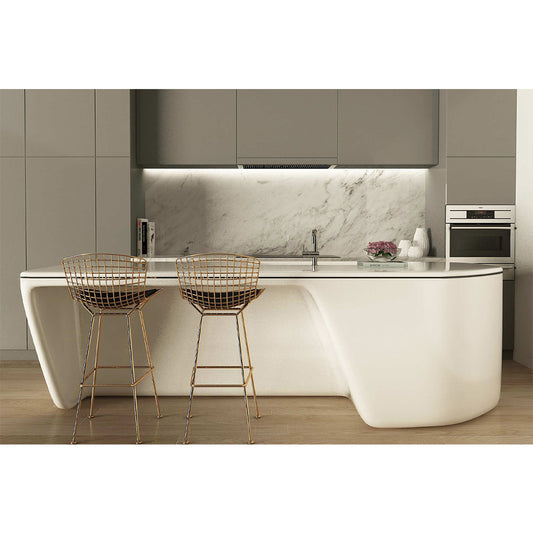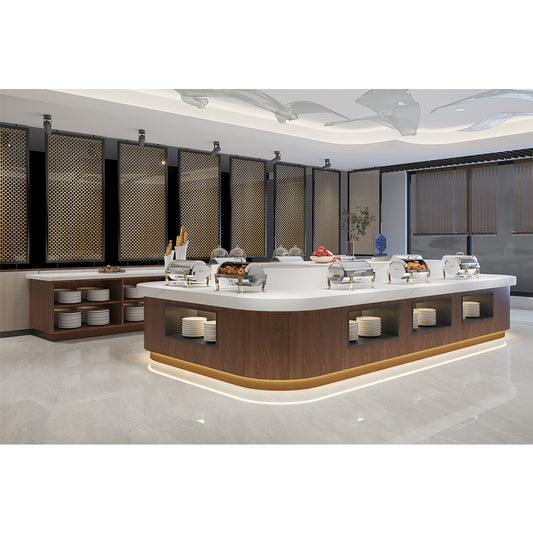Resin surface support refers to the support layer or frame used to reinforce a resin-based surface such as a countertop or other solid surface material. This support ensures that the resin surface remains stable, durable, and can withstand daily use. It usually involves the use of a substrate such as plywood or MDF (medium density fiberboard) below the resin surface.
The main components of solid surface are resin + aluminum powder + auxiliary materials (colorant, curing agent, etc.). Countertops are artificial surfaces made from a mixture of acrylic or polyester resins, fillers, and pigments. They have a smooth, non-porous and seamless appearance, making them ideal for kitchens and bathrooms. They are easy to maintain, durable, can be repaired if scratched, and come in a variety of colors and patterns. Special-shaped designs can be made to meet more customized services.

Are artificial stone countertops the same as solid surface countertops?
No, artificial stone countertops (such as quartz) and solid surface countertops are different:
Artificial stone (quartz): Made from natural quartz crystals combined with resin binders and pigments. They are harder and more heat-resistant than solid surface countertops.
Solid surface: Made of acrylic or polyester resin combined with mineral fillers and pigments. PMMA and aluminum powder and some colorants, fixatives and auxiliary materials. Their surface is softer, can be seamlessly connected, can be repaired, can be made into special designs, but is less heat-resistant than quartz.
How to make a solid surface countertop sparkle?
Tools: Harbor Freight sander Makita sander. With a 5'' pad.
Makita Grinder: Grinder
Makita sander with a 5" sanding pad from Harbor Freight. The thing works awesome. 40 grit sandpaper.
Aluminum Oxide Sandpaper
Grinder Buying Tips: Don't buy a regular grinder and expect to get the same results. Standard grinders are often not designed for the speeds you need to work with engineered stone. First, you need to vary the speed. Speeds above 2.75 will cause problems and will not give you the results you need for solid surface seams. Second, running a regular grinder at full speed will pit the surface and clog the sandpaper almost immediately.


1. Clean the surface: Use a mild detergent and a soft cloth to remove any dirt and grime.
2. Polish: Minor scratches can be removed with a non-abrasive scrubbing pad (such as 3M Scotch-Brite pad) to gently rub. For deeper scratches, fine sandpaper (220-320 grit) is needed, matte 220 grit and glossy 320 grit and above, you need to use specific artificial stone sandpaper to polish and then polish with a soft cloth. Follow the left to right and top to bottom, and polish in a circular motion.
Breakage repair:
When seamless repair, the strands are too thick, which is not good. Over time, the glue line will turn yellow under the light. Reference blog 21
3. Maintenance: Clean and polish the countertop regularly to maintain its shine. Avoid using harsh chemicals or abrasive cleaners.






1 comentario